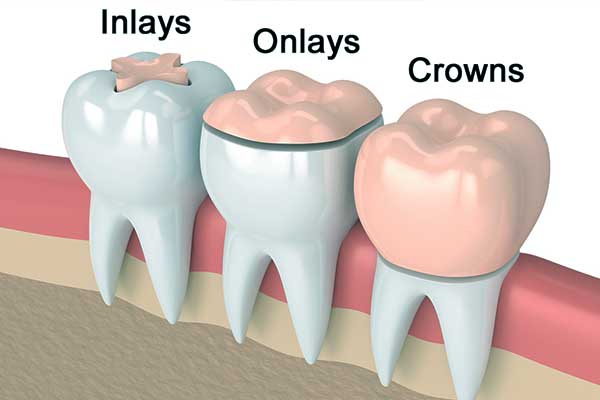inlays and onlays in Turkey

What are Inlays and Onlays?
When a cavity strikes, relying solely on the body’s natural healing process isn’t enough. That’s where proper dental intervention comes in. Traditional tooth fillings, typically composed of plastic or amalgam, have long been the go-to solution. While effective, they come with a caveat – they wear down over time, necessitating replacement.
Enter the modern marvel: inlays and onlays. These aren’t your ordinary fillings; they’re precision-crafted dental wonders. Picture this: a solid material meticulously shaped into a perfect fit in a dental laboratory. This tailor-made piece is then seamlessly bonded into the affected area. And for more extensive damage, we introduce the heavyweight champion – the onlay.
But here’s where the magic truly lies – durability. Inlays and onlays are built to last. Unlike their conventional counterparts, they’re designed to withstand the test of time. With proper care, they’re not just a temporary fix; they’re a lifelong investment in your oral health. Say goodbye to frequent replacements and hello to a lifetime of smiles.
Types of Inlays and Onlays
- Inlays: Inlays fit inside the tooth’s cusps, repairing damage within the biting surface.
- Onlays: Onlays cover more extensive damage, including one or more cusps of the tooth.
| Type of Inlay | Advantages | Disadvantages |
|---|---|---|
| Ceramic Inlay | – Precise color matching | – Potential for toothache due to hardness |
| – High biocompatibility | – Possible discomfort if not properly fitted | |
| – Nearly invisible appearance | ||
| Gold Inlay | – Longevity (at least 25 years) | – Complex processing |
| – Similar hardness to natural teeth | – Expensive | |
| – Aesthetic concerns | ||
| Cerec Inlay | – Same-day treatment | – Not suitable for all cases (e.g., extensive damage) |
| – Precise fit | – Requires specialized equipment and training | |
| – Ceramic material with high durability |
When comparing the different types of inlays, it’s clear that each has its own set of advantages and disadvantages. Ceramic inlays offer excellent aesthetics and biocompatibility but may pose a risk of toothache. Gold inlays boast longevity and natural hardness but are costly and less aesthetically pleasing. Cerec inlays provide convenience and precision but may not be suitable for extensive damage and require specialized equipment and training. Choose the type of inlay that best suits your needs and preferences, considering factors such as durability, aesthetics, and cost.
Procedure and Price
Procedure
- Consultation: Your dentist will examine your teeth and discuss treatment options.
- Preparation: The damaged area of the tooth is prepared by removing decay or old fillings.
- Impressions: Impressions of the tooth are taken to create custom-made inlays or onlays.
- Temporary Restoration: A temporary restoration may be placed while the permanent restoration is fabricated.
- Placement: The inlay or onlay is bonded to the tooth using dental cement.
Price
The cost of inlay and onlay procedures in Turkey varies depending on several factors, including the extent of damage, materials used, and clinic location. On average, the price ranges from [price range]. Our clinic offers competitive pricing without compromising quality.
Benefits of Inlays and Onlays
- Natural Appearance: Inlays and onlays are custom-made to match the color and shape of your natural teeth.
- Strength and Durability: These restorations provide strength and durability, allowing you to bite and chew comfortably.
- Preservation of Tooth Structure: Inlays and onlays require minimal removal of tooth structure compared to traditional fillings.
- Longevity: With proper care, inlays and onlays can last for many years, providing a long-term solution for damaged teeth.
- Protection: Inlays and onlays protect the remaining tooth structure from further damage or decay.
Minuses of Inlays and Onlays
While inlays and onlays offer numerous benefits, there are some considerations to keep in mind:
- Cost: The initial cost of inlays and onlays may be higher than traditional fillings.
- Multiple Visits: The procedure typically requires two or more visits to the dentist, extending the treatment process.
- Sensitivity: Some patients may experience temporary sensitivity after the procedure, which usually subsides over time.
- Risk of Fracture: In rare cases, inlays or onlays may fracture or become dislodged, requiring replacement.

Take action today to achieve the smile you deserve. Prioritize your dental health now and unlock a brighter, more confident future
Inlay or crown?
When faced with significant tooth damage and minimal tooth structure, the decision between a crown or an inlay becomes crucial for achieving both aesthetics and long-term durability. Below, we outline the key points to consider for each option:
| Option | Advantages | Disadvantages |
|---|---|---|
| Crown | – Excellent for cases with minimal tooth substance | – Requires extensive preparation |
| – Effective for advanced caries treatment | – High initial costs (typically £260-860) | |
| – Provides high-quality, long-lasting restoration | – Limited insurance coverage for certain crown types | |
| – Aesthetic, mimicking natural tooth appearance | ||
| Inlay | – Custom-fit restoration | – Requires meticulous preparation |
| – Aesthetic appeal, especially with ceramic materials | – High initial costs (similar to crowns) | |
| – High compatibility with natural teeth | – Limited insurance coverage, similar to crowns | |
| – Longevity, with a lifespan of over 25 years |
In summary, both crowns and inlays offer unique advantages and drawbacks. Crowns excel in cases with minimal tooth structure, providing excellent care for advanced caries and ensuring high-quality, durable restorations with aesthetic appeal. However, they involve extensive preparation and may incur higher costs, with limited insurance coverage for certain types.
On the other hand, inlays offer a custom-fit, aesthetically pleasing solution with high compatibility and longevity. While they also require meticulous preparation and come with similar initial costs to crowns, insurance coverage may be limited.
Ultimately, the choice between a crown and an inlay depends on individual circumstances, including the extent of tooth damage, aesthetic preferences, and budget considerations. Consulting with a dental professional can help determine the most suitable option for your specific needs.
![graph LR;
A[Turkey] --> B[Affordable Prices];
A --> C[Experienced Dentists];
A --> D[State-of-the-Art Facilities];
A --> E[Tourism Opportunities];
D --> F[Dental Implants];
D --> G[Cosmetic Dentistry];
D --> H[Restorative Dentistry];
D --> I[Oral Surgery];
H --> J[Fillings];
H --> K[Crowns and Bridges];
I --> L[Tooth Extractions];
I --> M[Wisdom Tooth Removal];
I --> N[Bone Grafting];](https://tintuc24h.info/wp-content/uploads/2024/04/Get-a-free-consultation-and-discount-now.jpg)
Transform your smile and boost your confidence with proactive dental care. Don’t wait – take the first step towards a brighter future today!
Frequently Asked Questions About inlays and onlays in Turkey
Is inlay and onlay expensive?
Inlay and onlay procedures can be relatively expensive compared to traditional fillings. The cost depends on factors such as the material used, the complexity of the procedure, and the dentist’s fees.
Which is better, inlay or onlay?
The choice between an inlay and an onlay depends on the extent of the tooth damage. Inlays are suitable for repairing damage within the biting surface of the tooth, while onlays are used for more extensive damage that includes one or more cusps of the tooth.
How long does an inlay and onlay last?
Inlays and onlays are designed to be durable, with a lifespan of over 25 years when properly cared for. However, their longevity can vary depending on factors such as oral hygiene practices and the material used for the restoration.
What is the disadvantage of inlay and onlay?
One potential disadvantage of inlays and onlays is the high initial cost compared to traditional fillings. Additionally, they require meticulous preparation and may not be fully covered by insurance.
What is the lifespan of an onlay?
Onlays, like inlays, have a lifespan of over 25 years when properly maintained. However, their longevity can be affected by factors such as oral hygiene habits and the material used for the restoration.
What is the most common failure of inlay/onlay?
The most common failure of inlays and onlays is debonding or detachment from the tooth surface. This can occur due to factors such as inadequate bonding, excessive forces on the restoration, or improper fit.
Can an onlay fall off?
Yes, an onlay can potentially fall off if it becomes debonded from the tooth surface. This can happen due to factors such as poor bonding, excessive force on the restoration, or inadequate fit.
Is a crown better than an onlay?
The choice between a crown and an onlay depends on the extent of tooth damage and other individual factors. Crowns are more suitable for cases with extensive damage or significant loss of tooth structure, while onlays are often preferred for preserving more natural tooth structure.
What are the risks of having an inlay/onlay?
Risks associated with inlays and onlays include potential debonding or detachment, sensitivity, and the need for replacement or repair in case of damage or wear over time. Additionally, there may be risks associated with the dental procedure itself, such as infection or discomfort.

Seize the opportunity today to attain the smile you deserve. Make your dental health a priority now and open the door to a brighter, more confident future.



